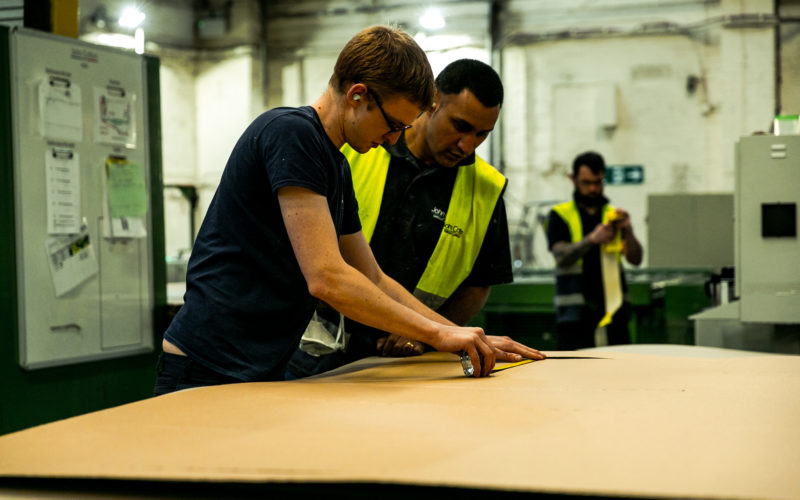Our Processes
Fibre opening and blending
Fibre is supplied in densely consolidated press-packed bales and needs to be opened prior to carding. The opening process converts the densely packed fibre bales containing fibre tufts to smaller tufts or in some cases individual fibres. It is traditionally said that ‘well opened is half carded’ and this old aged remark remains remarkably true, something the John Cotton Nonwovens Division has been practicing and perfecting for years.
Carding
The purpose of carding is to disentangle and blend fibres to form a parallel-laid and homogeneous web of consistent weight per unit area. This process is carried out in a series of fibre opening and layering actions achieved by the interaction of toothed rollers situated inside the carding machine.
The Nonwovens Division houses traditional and sophisticated state of the art carding machinery capable of processing webs made from both natural and synthetic fibres. In August 2016 the Nonwovens Division invested in a new state of the art carding line, coupled with a thermal bonding oven, resulting in the development of the first Monobloc wadding.
Airlaying
Airlaying involves uniformly dispersing fibres in an airstream onto a permeable screen or conveyor where the air is separated, and the fibres are randomly laid in the form of a web.
Typical material constructions made from this technique will be used for insulation applications such as loft insulation and chilled packaging.
Vertically laid web formation
A carded web, which normally contains a proportion of thermoplastic fibre, is formed into a series of vertical folds, using a reciprocating lapping device, immediately prior to through-air bonding.
John Cotton Nonwovens Division are the only company in Europe to house a ‘Vlap’ machine, allowing us to produce webs where the orientation of the fibres is laid in a vertical direction. This structure provides a number of benefits such as:
- Foam like structure and properties
- Greater resilience and recovery from compression
- Increased breathability
- Ability to convolute and zone to deliver targeted comfort
- Increased bulk without weight
- Rinse proof
- No VOC’s
- No odour
Needlepunching
Fibres are mechanically entangled/bonded to produce a fabric by reciprocating barbed needles (felting needles) through a moving batt of fibres in a needleloom.
At John Cotton Nonwovens Division, this technique is predominantly used to produce luxury mattresses fillings using natural fibres such as wool, cotton, silk, cashmere, alpaca and mohair.
Thermal bonding
A web consisting of thermoplastic and non-thermoplastic fibres is produced when passed through an oven, whereby the thermoplastic fibres are heated to their melting or softening temperature, followed by cooling and solidification, allowing the fibres to bond together.
The John Cotton Nonwovens Division installed a brand-new state of the art thermal bonding oven and carding line in August 2016, allowing for the development and production of the first Monobloc wadding material, winning the NBF Bed Component Supplier of the Year in September 2017. In July 2018, the Nonwovens Division also invested in a second state of the art thermal bonding oven to enhance the product output on our existing line.
Lamination
Lamination is the process of joining two or more pre-formed nonwoven materials through the use of adhesive, pressure and heat. The purpose of lamination is to modify the properties of the nonwoven structure, by providing added stability or barrier characteristics.
The Nonwovens Division houses a lamination service which is frequently used to apply nonwoven scrims to the surface of our vertically laid products.
Skinning
Using our lamination service, John Cotton Nonwoven Division can provide a skinned effect on the exterior face of our waddings. By providing heat to either side of the wadding surface, the thermoplastic fibres melt and solidify, creating a smooth skin appearance. This skin may provide improved structural stability, as well as other characteristic properties for filtration media.
Convoluting
To meet the demand from the UK mattress market, John Cotton Nonwovens Division have successfully developed and registered patent applications for the commercial production of convoluted and zoned vertically laid pads, providing targeted pressure relief and comfort.
Packaging automation
Our latest investment in automated packing technology, has enabled the Nonwovens Division to create unique insulated pouch systems for cold chain insulated packaging solutions.
Mattress component packaging
State of the art packaging equipment enables us to efficiently compress pack our mattress pads for efficient and effective delivery to our customers.























